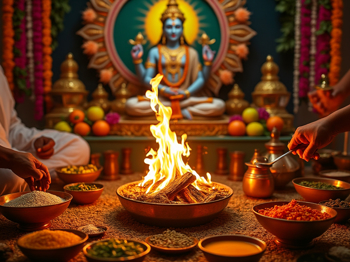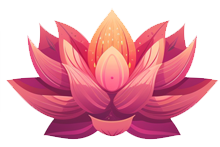- Spiritual Cleansing: The Birthday Puja and Havan help purify the mind, body, and surroundings, removing any accumulated negative energy and fostering a positive environment.
- Divine Blessings: Invoking the blessings of deities ensures protection, prosperity, and good health for the individual in the coming year.
- Renewal of Vows: It is a time to reflect on the past year, seek forgiveness for mistakes, and renew one's commitment to righteousness and spiritual growth.
- Gratitude and Devotion: The ceremony is an expression of gratitude towards the divine for the gift of life and the opportunities provided.
- Family Bonding: Performing the Puja and Havan together strengthens familial bonds, creating a collective sense of purpose and spiritual unity.
- Ensures good health and longevity.
- Removes obstacles and brings success in personal and professional life.
- Attracts positive energy and dispels negativity.
- Strengthens mental peace and emotional stability.
- Increases spiritual awareness and connection to the divine.
- Promotes harmony and unity within the family.
Performing a Birthday Puja and Havan is a beautiful way to express gratitude, seek blessings, and purify the environment. Here's a step-by-step guide to help you perform these rituals:
Materials Needed:
-
For Puja:
- Idol or picture of the deity (Lord Ganesha, Goddess Lakshmi, or your family deity)
- Flowers
- Fruits
- Incense sticks (Agarbatti)
- Diya (oil lamp)
- Kumkum, Haldi (turmeric), Akshata (rice mixed with turmeric)
- Panchamrit (a mixture of milk, yogurt, honey, ghee, and sugar)
- Fresh water
- Betel leaves and betel nuts
- A coconut
- Sweets for offering (Prasad)
-
For Havan:
- Havan Kund (a square-shaped metal or earthen vessel)
- Wood (Samidha) for the fire
- Cow ghee (clarified butter)
- Havan Samagri (a mixture of herbs and other offerings)
- Camphor
- A long spoon or ladle (for offering ghee into the fire)
- Water and flowers for sprinkling
Step-by-Step Procedure:
1. Preparation:
- Clean the area where the Puja and Havan will be performed.
- Take a bath and wear clean clothes.
- Place the deity's idol or picture on a clean cloth or a small altar.
2. Ganesh Puja (Invocation of Lord Ganesha):
- Light the Diya and incense sticks.
- Place some flowers and Akshata in front of Lord Ganesha.
- Offer Panchamrit and water, then gently wipe the deity with a clean cloth.
- Chant the following mantra or simply say, "Om Gan Ganapataye Namah":
Vakratunda Mahakaya Suryakoti Samaprabha Nirvighnam Kuru Me Deva Sarva Karyeshu Sarvada
3. Sankalpa (Resolve):
- Take some water, flowers, and Akshata in your right hand, and make a resolve or intention for the Puja and Havan.
- State your name, gotra (if known), and the purpose (i.e., birthday blessings) before the deity.
4. Main Puja:
- Offer flowers, fruits, and sweets to the deity.
- Apply Kumkum and Haldi to the deity, followed by offering Akshata.
- Chant prayers or mantras dedicated to the deity. You can also recite the 108 names of the deity.
- Arti: Perform the Arti by circling the Diya around the deity while singing or reciting the Arti song.
5. Birthday Ritual:
- If the person whose birthday it is, is present, apply Kumkum and Akshata to their forehead.
- Offer them a flower garland and perform an Arti for them.
6. Havan (Fire Ritual):
- Set up the Havan Kund in the center of the space.
- Place small pieces of wood (Samidha) in the Havan Kund.
- Light the fire using camphor.
- Invoke Agni (the fire god) by offering ghee into the fire while chanting "Om Agnaye Svaha" and dropping the ghee into the fire with each "Svaha".
7. Offerings (Ahutis):
Om Idam Namama
Om Prajapataye Svaha
- You can also chant the Gayatri Mantra:
Om Bhur Bhuvah Svah
Tat Savitur Varenyam
Bhargo Devasya Dhimahi
Dhiyo Yonah Prachodayat
- Continue offering the Samagri and ghee into the fire with each "Svaha".
8. Purna Ahuti (Final Offering):
- For the final offering, place some Samagri, a betel nut, and a coconut into the fire while chanting the mantra.
- Perform a silent prayer, seeking blessings and expressing gratitude.
9. Concluding the Rituals:
- Sprinkle water around the Havan Kund to purify the space.
- Offer Prasad (the sweets offered to the deity) to everyone present.
- Express gratitude to the deities and request them to leave (Uttara Puja).
- Distribute the Prasad and share the blessings.
10. Clean-up:
- After the Havan, clean the space, and dispose of the ashes respectfully by immersing them in water or placing them under a tree.
This ritual can be performed at home or in a temple. The essence of the Birthday Puja and Havan lies in the devotion and sincerity with which it is performed.




